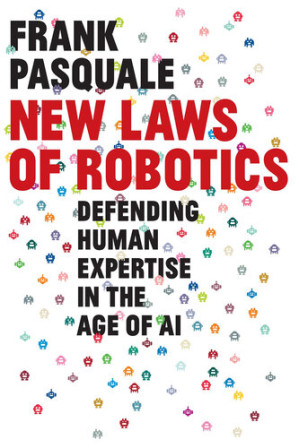 Zusammenfassungen
Zusammenfassungen
 AI is poised to disrupt our work and our lives. We can harness these technologies rather than fall captive to them—but only through wise regulation. Too many CEOs tell a simple story about the future of work: if a machine can do what you do, your job will be automated. They envision everyone from doctors to soldiers rendered superfluous by ever-more-powerful AI. They offer stark alternatives: make robots or be replaced by them. Another story is possible. In virtually every walk of life, robotic systems can make labor more valuable, not less. Frank Pasquale tells the story of nurses, teachers, designers, and others who partner with technologists, rather than meekly serving as data sources for their computerized replacements. This cooperation reveals the kind of technological advance that could bring us all better health care, education, and more, while maintaining meaningful work. These partnerships also show how law and regulation can promote prosperity for all, rather than a zero-sum race of humans against machines. How far should AI be entrusted to assume tasks once performed by humans? What is gained and lost when it does? What is the optimal mix of robotic and human interaction? New Laws of Robotics makes the case that policymakers must not allow corporations or engineers to answer these questions alone. The kind of automation we get—and who it benefits—will depend on myriad small decisions about how to develop AI. Pasquale proposes ways to democratize that decision making, rather than centralize it in unaccountable firms. Sober yet optimistic, New Laws of Robotics offers an inspiring vision of technological progress, in which human capacities and expertise are the irreplaceable center of an inclusive economy.
AI is poised to disrupt our work and our lives. We can harness these technologies rather than fall captive to them—but only through wise regulation. Too many CEOs tell a simple story about the future of work: if a machine can do what you do, your job will be automated. They envision everyone from doctors to soldiers rendered superfluous by ever-more-powerful AI. They offer stark alternatives: make robots or be replaced by them. Another story is possible. In virtually every walk of life, robotic systems can make labor more valuable, not less. Frank Pasquale tells the story of nurses, teachers, designers, and others who partner with technologists, rather than meekly serving as data sources for their computerized replacements. This cooperation reveals the kind of technological advance that could bring us all better health care, education, and more, while maintaining meaningful work. These partnerships also show how law and regulation can promote prosperity for all, rather than a zero-sum race of humans against machines. How far should AI be entrusted to assume tasks once performed by humans? What is gained and lost when it does? What is the optimal mix of robotic and human interaction? New Laws of Robotics makes the case that policymakers must not allow corporations or engineers to answer these questions alone. The kind of automation we get—and who it benefits—will depend on myriad small decisions about how to develop AI. Pasquale proposes ways to democratize that decision making, rather than centralize it in unaccountable firms. Sober yet optimistic, New Laws of Robotics offers an inspiring vision of technological progress, in which human capacities and expertise are the irreplaceable center of an inclusive economy. Dieses Buch erwähnt ...
Dieses Buch erwähnt ...
 Personen KB IB clear | Ajay Agrawal , Meredith Broussard , Bobby Chesney , Danielle Citron , Joshua Gans , Avi Goldfarb | |||||||||||||||||||||||||||
 Begriffe KB IB clear |  Aibo
, Bildungeducation (Bildung)
, Aibo
, Bildungeducation (Bildung)
,  Computer Computer computer
, computer
,  LehrerIn LehrerIn teacher
, teacher
,  Maschine Maschine machine
, machine
,  Roboter Roboter robot
, uncanny valley
, robot
, uncanny valley
,  Vertrauen Vertrauen trust trust
| |||||||||||||||||||||||||||
 Bücher |
| |||||||||||||||||||||||||||
 Texte |
|
 Dieses Buch erwähnt vermutlich nicht ...
Dieses Buch erwähnt vermutlich nicht ... 
 Nicht erwähnte Begriffe | Digitalisierung, Kinder, Lernen, Schule, Unterricht |
 Tagcloud
Tagcloud
 Zitationsgraph
Zitationsgraph
 Zitationsgraph (Beta-Test mit vis.js)
Zitationsgraph (Beta-Test mit vis.js)
 5 Erwähnungen
5 Erwähnungen 
- Democracy in Flux: Order, Dynamics and Voices in Digital Public Spheres - Proceedings of the Weizenbaum Conference 2021 (2021)


- Education andTechnology - Key Issues and Debates (3rd edition) (Neil Selwyn) (2022)

- The future of AI and education - Some cautionary notes (Neil Selwyn) (2022)


- Critical Data Literacies - Rethinking Data and Everyday Life (Luci Pangrazio, Neil Selwyn) (2023)

- The impact of generative artificial intelligence on socioeconomic inequalities and policymaking (Valerio Capraro, Austin Lentsch, Daron Acemoglu, Selin Akgun, Aisel Akhmedova, Ennio Bilancini, Jean-François Bonnefon, Pablo Brañas-Garza, Luigi Butera, Karen Douglas, Jim Everett, Gerd Gigerenzer, Christine Greenhow, Daniel Hashimoto, Julianne Holt-Lunstad, Jolanda Jetten, Simon Johnson, Werner Kunz, Chiara Longoni, Pete Lunn, Simone Natale, Stefanie Paluch, Iyad Rahwan, Neil Selwyn, Vivek Singh, Siddharth Suri, Jennifer Sutcliffe, Joe Tomlinson, Sander van der Linden, Paul Van Lange, Friederike Wall, Jay Van Bavel, Riccardo Viale) (2024)


 Volltext dieses Dokuments
Volltext dieses Dokuments
 | New Laws of Robotics: Gesamtes Buch als Volltext ( : 1100 kByte) : 1100 kByte) |
 | New Laws of Robotics: Gesamtes Buch als Volltext ( : :  , 5060 kByte) , 5060 kByte) |
 Anderswo suchen
Anderswo suchen 
 Beat und dieses Buch
Beat und dieses Buch
Beat hat dieses Buch während seiner Zeit am Institut für Medien und Schule (IMS) ins Biblionetz aufgenommen. Beat besitzt kein physisches, aber ein digitales Exemplar. (das er aber aus Urheberrechtsgründen nicht einfach weitergeben darf). Es gibt bisher nur wenige Objekte im Biblionetz, die dieses Werk zitieren.











 Biblionetz-History
Biblionetz-History